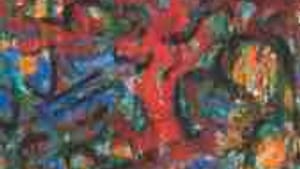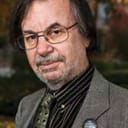Stay in the Loop
BSR publishes on a weekly schedule, with an email newsletter every Wednesday and Thursday morning. There’s no paywall, and subscribing is always free.
Out in the Hamptons
Hamptons Abstract Expressionists in New York

The Hamptons may be a tony Long Island address today, but the village of East Hampton was also the site of some of the 20th Century's most remarkable painting. Everyone knows that Pollock and De Kooning lived and worked there, and Pollock's studio— a wooden shed splattered from floor to ceiling with the disjecta membra of his art— is a shrine of sorts.
But from the '40s through the '60s and beyond, East Hampton was also home to many fine artists beyond the marquee names, who took their own paths to abstraction and whose work not only sets the Expressionist era in wider perspective but also substantially enriches it. The Findlay Gallery, now in its new and expanded Fifth Avenue home, has put up an exceptional show of some of these artists. They're well worth attention, and in some cases they demand it.
I've long felt that Robert Richenburg (1917-2006) belongs in any discussion of the major figures of Abstract Expressionism. Two strong works of his were among those on display here: Undeniable (1956) and The City (1960). They're as different as can be. Undeniable is a bold, thickly impastoed work with reds, greens and browns predominating, and a "zip" in the upper center that may be an homage to Barnet Newman.
Echoes of Mondrian
The City is an early example of the so-called black paintings that Richenburg began to do at the end of the '50s, in which an initial ground was completely overpainted in black and then partially scraped away to reveal patterning underneath. It's a quieter and more lyrical piece than some of the later, larger work in this vein, which suggest a cosmic sublime (and also evoke, I've been thinking lately, the jazzy rhythms of Mondrian).
Important work, one likes to believe, never really gets lost, although it may need to wait for its due. The best of Richenburg's stands easily beside far better known artists, and his day is yet to come.
A coup for this exhibit was Callistro, a tinted brass sculpture by Ibrahim Lassaw, whose work has seldom been shown in recent years. There's an improvisatory quality to the piece, but also a sense of strong organic grounding that charges the space around it.
Philip Pavia's nearby black bronzes, modestly scaled and compactly powerful, suggest totemic figures, sensitively yet commandingly poised. They were nicely placed in dialogue with David Slivka's black ink drawings on the wall opposite.
Shattered hopes
Other artists prominently represented included John Ferren, particularly by his One World, a large spherical form that shows the planet as a ball of yarn whose parti-colored threads may be seen as coming together or coming apart—a wry yet playful commentary on the hopes (long shattered now) for postwar community.
There are a trio of Herman Cherrys, most impressively his large-scale Number Two (1958), and another group by Kyle Morris, a restlessly experimental painter whose red-hued Number Two (1953) both reflects the graphic work Philip Guston had recently exhibited while seeming to anticipate some of Guston's yet-unpainted masterpieces of the mid-'50s. This isn't to argue for influence one way or another, but simply to suggest an intensely charged atmosphere in which artists continually sparked off one another.
The world had been like that when Impressionism was young, and again in the early days of Cubism. American Abstract Expressionism was a third such moment, and its depth and wealth— by no means fully explored, even today— is suggested by the community of artists who made the Hamptons their home.
Terror of beauty
The Findlay gallery's east wing, meanwhile, had a solo show by the West Coast artist Walter Kuhlman (1918-2009), a Bay area Abstract Expressionist who moved toward figuration later in his career just as colleagues like Richard Diebenkorn were moving in the opposite direction. Kuhlman became fascinated by the demanding graphic art form of the monotype, whose handful of truly successful practitioners—Degas comes most immediately to mind—are a kind of elite guild within the world of art. Kuhlman is of their number.
The works on display, dating from the 1980s and '90s, unfold a private mythology of alienation and quest whose mysterious, hermetic figures emerge from mystery and seem to pass into it again. In their midst is a single powerful seascape, which anchors the entire suite in a gesture toward the natural world while also serving as an oblique commentary on the human predicament in it. We live alongside the light, Kuhlman seems to say, yet choose the darkness.
It isn't that simple, of course: Beauty in a God-abandoned world has a special terror all its own. But art isn't about answering questions; its job is to point out they're there. Kuhlman's haunting images, with their roots in Redon and Kubin, represent one man's report on a void we can all recognize.
But from the '40s through the '60s and beyond, East Hampton was also home to many fine artists beyond the marquee names, who took their own paths to abstraction and whose work not only sets the Expressionist era in wider perspective but also substantially enriches it. The Findlay Gallery, now in its new and expanded Fifth Avenue home, has put up an exceptional show of some of these artists. They're well worth attention, and in some cases they demand it.
I've long felt that Robert Richenburg (1917-2006) belongs in any discussion of the major figures of Abstract Expressionism. Two strong works of his were among those on display here: Undeniable (1956) and The City (1960). They're as different as can be. Undeniable is a bold, thickly impastoed work with reds, greens and browns predominating, and a "zip" in the upper center that may be an homage to Barnet Newman.
Echoes of Mondrian
The City is an early example of the so-called black paintings that Richenburg began to do at the end of the '50s, in which an initial ground was completely overpainted in black and then partially scraped away to reveal patterning underneath. It's a quieter and more lyrical piece than some of the later, larger work in this vein, which suggest a cosmic sublime (and also evoke, I've been thinking lately, the jazzy rhythms of Mondrian).
Important work, one likes to believe, never really gets lost, although it may need to wait for its due. The best of Richenburg's stands easily beside far better known artists, and his day is yet to come.
A coup for this exhibit was Callistro, a tinted brass sculpture by Ibrahim Lassaw, whose work has seldom been shown in recent years. There's an improvisatory quality to the piece, but also a sense of strong organic grounding that charges the space around it.
Philip Pavia's nearby black bronzes, modestly scaled and compactly powerful, suggest totemic figures, sensitively yet commandingly poised. They were nicely placed in dialogue with David Slivka's black ink drawings on the wall opposite.
Shattered hopes
Other artists prominently represented included John Ferren, particularly by his One World, a large spherical form that shows the planet as a ball of yarn whose parti-colored threads may be seen as coming together or coming apart—a wry yet playful commentary on the hopes (long shattered now) for postwar community.
There are a trio of Herman Cherrys, most impressively his large-scale Number Two (1958), and another group by Kyle Morris, a restlessly experimental painter whose red-hued Number Two (1953) both reflects the graphic work Philip Guston had recently exhibited while seeming to anticipate some of Guston's yet-unpainted masterpieces of the mid-'50s. This isn't to argue for influence one way or another, but simply to suggest an intensely charged atmosphere in which artists continually sparked off one another.
The world had been like that when Impressionism was young, and again in the early days of Cubism. American Abstract Expressionism was a third such moment, and its depth and wealth— by no means fully explored, even today— is suggested by the community of artists who made the Hamptons their home.
Terror of beauty
The Findlay gallery's east wing, meanwhile, had a solo show by the West Coast artist Walter Kuhlman (1918-2009), a Bay area Abstract Expressionist who moved toward figuration later in his career just as colleagues like Richard Diebenkorn were moving in the opposite direction. Kuhlman became fascinated by the demanding graphic art form of the monotype, whose handful of truly successful practitioners—Degas comes most immediately to mind—are a kind of elite guild within the world of art. Kuhlman is of their number.
The works on display, dating from the 1980s and '90s, unfold a private mythology of alienation and quest whose mysterious, hermetic figures emerge from mystery and seem to pass into it again. In their midst is a single powerful seascape, which anchors the entire suite in a gesture toward the natural world while also serving as an oblique commentary on the human predicament in it. We live alongside the light, Kuhlman seems to say, yet choose the darkness.
It isn't that simple, of course: Beauty in a God-abandoned world has a special terror all its own. But art isn't about answering questions; its job is to point out they're there. Kuhlman's haunting images, with their roots in Redon and Kubin, represent one man's report on a void we can all recognize.
What, When, Where
“East End: Artists of the Hamptons†and “Walter Kuhlman: Images from the West.†Closed October 22, 2011 at David Findlay Jr. Gallery, 724 Fifth Ave., New York. (212) 486-7660 or www.davidfindlayjr.com.
Sign up for our newsletter
All of the week's new articles, all in one place. Sign up for the free weekly BSR newsletters, and don't miss a conversation.
 Robert Zaller
Robert Zaller